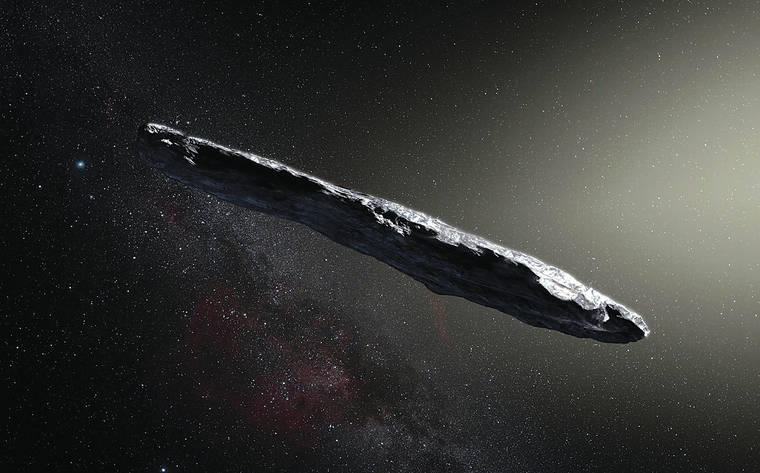There is still much that scientists do not know about ‘Oumuamua, the interstellar object that was discovered passing through our solar system in 2017. But most agree that it probably isn’t the work of aliens.
However, Harvard astrophysicist Avi Loeb has suggested otherwise.
Since the object was discovered by astronomers using the Pan-STARRS telescope at Haleakala Observatory, Loeb has speculated that certain abnormalities about the object could be indications it was the product of extraterrestrial intelligence.
Most recently, Loeb published an opinion piece in “Scientific American” in June, arguing that the observed properties of ‘Oumuamua could indicate it was an alien signal receiver.
“One might even wonder whether ‘Oumuamua might have been retrieving data from probes that were already sprinkled on Earth at an earlier time,” Loeb wrote.
But although Loeb’s statements have made headlines — and come about six months after he published a book about his theories — other astronomers have called them unscientific at best and irresponsible at worst.
“I’m a little frustrated with him, to be honest,” said Karen Meech, interim director for the University of Hawaii’s Institute for Astronomy, and the leader of an international research team that studied ‘Oumuamua in 2017. “Aliens are exciting, and I get that when you see something totally brand new, it can be fun to speculate. But he could have done better to engage with the scientific community and ask what it would take to convince us.”
Doug Simons, who will become the IFA director in September, said ‘Oumuamua is “on the margins” of what is easily explainable by current science, and much of the nature of the object is still shrouded in hypothesis and conjecture. But nothing that has been observed about ‘Oumuamua cannot be explained by conventional physics, he said.
“It’s unclear to me what (Loeb) is trying to achieve with this,” Simons said. “We have explanations that don’t require exotic physics or alien technology.”
In particular, Loeb has pointed to ‘Oumuamua’s unusual shape as possible evidence of artificial origins.
Writing that the object is disc-shaped, Loeb suggested that it could be intended to receive signals from probes deposited on planets such as Earth. Furthermore, the shape could also act as a solar sail, which would account for the object’s apparent acceleration as it began its trajectory out of our solar system.
But Simons and Meech said that theory has holes, not least of which is that the shape of the object is not settled.
Meech said the reflections of light from the object suggest that it is long and thin, but it is tumbling in an erratic way that has made it impossible to conclusively resolve its shape — it could be either cigar-shaped or disc-shaped, Meech said.
Simons said the acceleration of ‘Oumuamua out of our solar system could be explained by a release of gas from the object’s surface.
One theory, he said, posits that the object could be covered in frozen nitrogen, which, when heated by the sun’s rays, turns to gas and propels the object faster through space.
Meech said astronomers did not detect certain gases being emitted from the object, but added that astronomers also didn’t have time to search for every possible substance.
“We only had a week to gather all the data we could on ‘Oumuamua. We have a week’s worth of data, and that’s all the data we will ever have on it,” Meech said.
The object is currently somewhere in the approximately 100 million miles between the orbits of Uranus and Neptune on a one-way trip out of our solar system.
Meech said she understands the allure of speculation — even her team indulged in it when they looked over ‘Oumuamua’s unusual data, she said.
“(Loeb) has said in the past that scientists are too afraid to admit when something might be something we can’t explain,” Meech said. “But that’s the thing — we did ask the ‘what-ifs’! But then we have to follow the scientific method.”
Even though speculation about aliens can be fun, Simons said the provable facts about the matter can be just as exciting.
“We’re keen to engage with the public, but I think the object is interesting unto itself,” Simons said. “People got excited just about the name! There were literally billions of search results for the name in the weeks after it was named.”
‘Oumuamua was named by UH-Hilo Hawaiian language professor Larry Kimura and ‘Imiloa Astronomy Center executive director Ka‘iu Kimura. The name is Hawaiian for “scout.”
In any case, astronomers continue to search for the next ‘Oumuamua. Meech said ‘Oumuamua was the first interstellar object to be discovered, but is likely far from the first to exist.
Email Michael Brestovansky at mbrestovansky@hawaiitribune-herald.com






